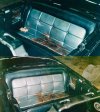Nemon
Active Member
This issue is based on a NYT-Times interview with Paul Landis Jr, one of the USSS bodyguards in JFK's motorcade when the president was shot in Dallas.
Since the original article is behind a paywall at the New York Times ( https://www.nytimes.com/2023/09/09/us/politics/jfk-assassination-witness-paul-landis.html ), I can only refer to the media response. I consider the Guardian a reliable source, so I quote this British newspaper. However, there are many other comparable reports and discussions.
This is about the Connally bullet (alleged "magic bullet" on the part of conspiracy theorists), which brings some implications...
Here is the facts as presented by the Guardian ( https://www.theguardian.com/us-news/2023/sep/11/jfk-assasination-multiple-shooters-paul-landis )
It has been quite a while since I have been intensively occupied with details from the labyrinth of JFK's assassination and discussed them in a forum. At least I could find one (of two?) testimonies of Landis.
At the top of page 756, the scene begins where Paul Landis has access to the presidential limousine, but mentions nothing of what he now reveals: https://www.history-matters.com/archive/jfk/wc/wcvols/wh18/html/WH_Vol18_0383a.htm
Now a nurse from that time also supports Landis' current statements. With all the hair-raisingly inaccurate and erroneous statements that came from the hospital staff, among other things, about the skull injuries, I do not attach any particular importance to this.
But basically this matter is very remarkable. What do you think about it? Have you found any further relevant facts and opinions from the current debate about this topic?
Since the original article is behind a paywall at the New York Times ( https://www.nytimes.com/2023/09/09/us/politics/jfk-assassination-witness-paul-landis.html ), I can only refer to the media response. I consider the Guardian a reliable source, so I quote this British newspaper. However, there are many other comparable reports and discussions.
This is about the Connally bullet (alleged "magic bullet" on the part of conspiracy theorists), which brings some implications...
Here is the facts as presented by the Guardian ( https://www.theguardian.com/us-news/2023/sep/11/jfk-assasination-multiple-shooters-paul-landis )
[...]
Landis was on the running board of a car trailing the open-top limousine that Kennedy was riding when – as he tells it – he heard a barrage of gunshots and a bullet struck the president from behind. The Warren commission, convened to examine the investigation, concluded that one bullet then continued forward, striking fellow passenger and Texas governor John Connally in his back, thigh, chest and wrist.
As the New York Times noted, the main reason for that conclusion was because the bullet was found on a stretcher used to move Connally around a hospital afterward.
[...] Landis told the New York Times that he was the person who discovered that bullet, which he remembers being stuck in the limousine seat behind Kennedy’s seat after the president had been brought to the hospital.
Landis also said he did not think the bullet went too deeply into Kennedy’s back before “popping back out” prior to the president’s removal from the car he was in. Worried someone would try to pocket it as a souvenir, Landis said he took the bullet and placed it next to a stretchered Kennedy.
“It was a piece of evidence that I realized right away [was] very important,” Landis said. “And I didn’t want it to disappear or get lost. So it was, ‘Paul, you’ve got to make a decision’ – and I grabbed it.”
Realizing in 2014 that the location of the bullet’s recovery cited by him was different than the one mentioned by the Warren commission, Landis checked with multiple officials, according to the New York Times’s story. He was generally met with skepticism, largely because of two written statements that he filed himself.
Neither statement mentioned his finding the bullet in question, and he reported hearing only a pair of gunshots at the time of the assassination, the Times wrote.[...]
It has been quite a while since I have been intensively occupied with details from the labyrinth of JFK's assassination and discussed them in a forum. At least I could find one (of two?) testimonies of Landis.
At the top of page 756, the scene begins where Paul Landis has access to the presidential limousine, but mentions nothing of what he now reveals: https://www.history-matters.com/archive/jfk/wc/wcvols/wh18/html/WH_Vol18_0383a.htm
Now a nurse from that time also supports Landis' current statements. With all the hair-raisingly inaccurate and erroneous statements that came from the hospital staff, among other things, about the skull injuries, I do not attach any particular importance to this.
But basically this matter is very remarkable. What do you think about it? Have you found any further relevant facts and opinions from the current debate about this topic?

